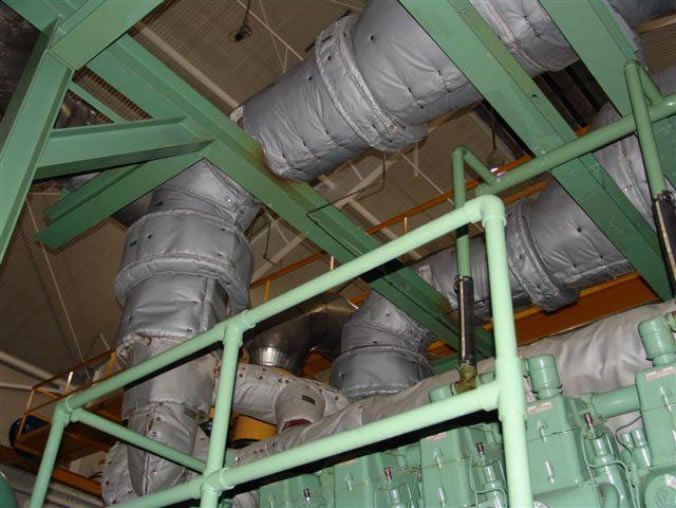ENGINE EXHAUST POWER GENERATION
HT1100MSGM (HT593C-MSGM)
INTRODUCTION
Shannon Thermal Blankets are a CAD designed, CNC produced, high quality pre-engineered insulation system designed to save energy, retain radiant heat, minimize insulation maintenance and improve the surrounding work environment. Shannon is weather resistant and chemical resistant. Shannon is flexible and easy to install, remove and reinstall allowing quick access and easy equipment serviceability. The key benefit is re-usability.
Common Applications and Markets
Shannon Thermal Blanket Applications include: Engine Manifolds, Exhaust Reducer Cones, Mufflers, Expansion Joints, Exhaust piping, Fittings, By-Pass Piping and Turbo Charger Casings. Shannon Thermal Blanket Markets include; Gas Transmission Stations and Cogeneration Power Plants.
Service Temperature
Engine & Turbine Systems – This design is to act as a Thermal Barrier with a maximum service temperature of 1100˚F (593˚C).
Product Components
The Outer Jacketing consists of a layer of Stainless Steel Type 304 Knitted Wire Mesh (.011” Dia. @ 16SF/LB – 0.28 mm Dia. @ 3.3 m²/kg) and 17.0 oz/yd² (577g/m²) Silicone Impregnated Fiberglass Cloth. The inner jacketing consists of a layer of Stainless Steel Knitted Wire Mesh (same as above) on the outside, encasing a layer of 18.0 oz/yd² (611g/m²) Plain Fiberglass Cloth. The Insulation Material is a 176.2 kg/m³ (11 lb/ft³ ) Fiberglass Needled Mat-Type E Fiber. The Fiberglass Mat is encapsulated by the Knitted SS Mesh, Silicone Cloth, Plain Fiberglass Cloth and SS Mesh, then stapled together, producing a Self Contained Blanket System. The Blanket System includes an integral fastener for install & removal.

Dual Engine Exhaust
BLANKET THICKNESS SURFACE TEMPERATURE REFERENCE
Operating Temp |
Thickness |
Surface Temp |
Thickness |
Surface Temp |
Thickness |
Surface Temp |
|---|---|---|---|---|---|---|
| 371˚ C (700˚ F) | 40 mm (1.5″) | 69.2˚ C (156.5˚ F) | 50 mm (2″) | 59.8˚ C (139.6˚ F) | 65 mm (2.5″) | 53.6˚ C (128.4˚ F) |
| 427˚ C (800˚ F) | 40 mm (1.5″) | 79.2˚ C (174.6˚ F) | 50 mm (2″) | 68.1˚ C (154.5˚ F) | 65 mm (2.5″) | 60.7˚ C (141.2˚ F) |
| 482˚ C (900˚ F) | 40 mm (1.5″) | 90.3˚ C (194.5˚ F ) | 50 mm (2″) | 77.2˚ C (171.0˚ F ) | 65 mm (2.5″) | 68.6˚ C (155.4˚ F ) |
| 538˚ C (1000˚ F) | 50 mm (2″) | 87.4˚ C (189.4˚ F) | 65 mm (2.5″) | 77.3˚ C (171.2˚ F) | 80 mm (3″) | 70.1˚ C (158.1˚ F) |
| 593˚ C (1100˚ F) | 50 mm (2″) | 98.7˚ C (209.7˚ F) | 65 mm (2.5″) | 87.1˚ C (188.8˚ F) | 80 mm (3″) | 78.7˚ C (173.7˚ F) |
* The above referenced Cold Face Surface Temperatures should be used as guidelines for blanket insulation thickness design.
* The Cold Face Surface Temperature of the blanket should approach surrounding ambient temperature conditions.
* The economic thickness of the blanket should consider blanket cost, thermal performance and blanket design constraints.
* Heat loss calculations are based on a 21.1˚ C (70˚ F) ambient temperature using a flat surface condition.
